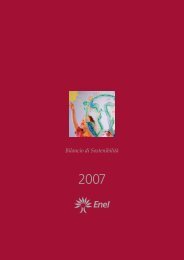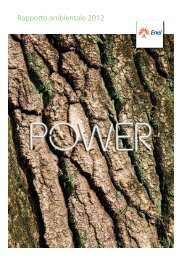Annual Report 2010 - Enel.com
Annual Report 2010 - Enel.com
Annual Report 2010 - Enel.com
Create successful ePaper yourself
Turn your PDF publications into a flip-book with our unique Google optimized e-Paper software.
Financial liabilities<br />
Financial liabilities other than derivatives are recognized<br />
at the settlement date when the <strong>com</strong>pany be<strong>com</strong>es a<br />
party to the contractual clauses representing the instrument<br />
and are initially measured at fair value, less directly<br />
attributable transaction costs. Financial liabilities are subsequently<br />
measured at amortized cost using the effective<br />
interest rate method.<br />
Derivative financial instruments<br />
Derivatives are recognized at fair value and are designated<br />
as hedging instruments when the relationship between<br />
the derivative and the hedged item is formally documented<br />
and the effectiveness of the hedge (assessed periodically)<br />
meets the thresholds envisaged under IAS 39.<br />
The manner in which the result of measurement at fair value<br />
is recognized depends on the type of hedge accounting<br />
adopted.<br />
When the derivatives are used to hedge the risk of changes<br />
in the fair value of hedged assets or liabilities, any<br />
changes in the fair value of the hedging instrument are<br />
taken to profit or loss. The adjustments in the fair values<br />
of the hedged assets or liabilities are also taken to profit<br />
or loss.<br />
When derivatives are used to hedge the risk of changes in<br />
the cash flows generated by the hedged items (cash flow<br />
hedges), changes in fair value are initially recognized in<br />
equity, in the amount qualifying as effective, and subsequently<br />
released to profit or loss in line with the gains and<br />
losses on the hedged item.<br />
The ineffective portion of the fair value of the hedging instrument<br />
is taken to profit or loss.<br />
Changes in the fair value of trading derivatives and those<br />
that no longer qualify for hedge accounting under IAS 39<br />
are recognized in profit or loss.<br />
Derivative financial instruments are recognized at the<br />
trade date.<br />
Financial and non-financial contracts (that are not already<br />
measured at fair value) are analyzed to identify any embedded<br />
derivatives, which must be separated and measured<br />
at fair value. This analysis is conducted at the time<br />
the entity be<strong>com</strong>es party to the contract or when the contract<br />
is renegotiated in a manner that significantly changes<br />
the original associated cash flows.<br />
Fair value is determined using the official prices for instruments<br />
traded on regulated markets. For instruments not<br />
traded on regulated markets fair value is determined on<br />
the basis of the present value of expected cash flows using<br />
162 <strong>Enel</strong> <strong>Annual</strong> <strong>Report</strong> <strong>2010</strong> Consolidated financial statements<br />
the market yield curve at the reporting date and translating<br />
amounts in currencies other than the euro at end-year<br />
exchange rates.<br />
The Group also analyzes all forward contracts for the purchase<br />
or sale of non-financial assets, with a specific focus<br />
on forward purchases and sales of electricity and energy<br />
<strong>com</strong>modities, in order to determine if they must be classified<br />
and treated in conformity with IAS 39 or if they have<br />
been entered into for physical delivery in line with the<br />
normal purchase/sale/use needs of the <strong>com</strong>pany (own<br />
use exemption).<br />
If such contracts have not been entered into in order to<br />
deliver electricity or energy <strong>com</strong>modities, they are measured<br />
at fair value.<br />
Derecognition of financial assets and liabilities<br />
Financial assets are derecognized when the rights to receive<br />
the cash flows associated with the instrument expire<br />
or the <strong>com</strong>pany has transferred substantially all the risks<br />
and rewards associated with ownership or control of the<br />
instrument.<br />
Financial liabilities are derecognized when they are extinguished<br />
or the <strong>com</strong>pany transfers all the risks and benefits<br />
associated with the instrument.<br />
Fair value hierarchy pursuant to IFRS 7<br />
Assets and liabilities measured at fair value are classified<br />
in a three-level hierarchy as described below, in consideration<br />
of the inputs used to determine such fair value.<br />
In particular:<br />
> Level 1 includes financial assets or liabilities measured<br />
at fair value on the basis of quoted prices in active markets<br />
for such instruments (unadjusted);<br />
> Level 2 includes financial assets/liabilities measured at<br />
fair value on the basis of inputs other than those included<br />
in Level 1 that are observable either directly or<br />
indirectly on the market;<br />
> Level 3 includes financial assets/liabilities whose fair<br />
value was calculated using inputs not based on observable<br />
market data.<br />
Post-employment and other employee<br />
benefits<br />
Liabilities related to employee benefits paid upon leaving<br />
or after ceasing employment in connection with defined<br />
benefit plans or other long-term benefits accrued during<br />
the employment period, which are recognized net of any









